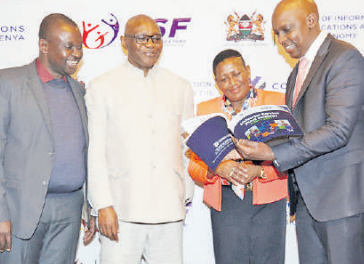The government has unveiled an ambitious Sh40 billion last-mile connectivity strategy targeting 100 per cent access to digital infrastructure.
The Universal Service Fund (USF) 2023-2027 by the Communications Authority (CA) is riding on the previous five year plan that has availed mobile connectivity to an additional 177 sub-locations, connected 886 public secondary schools to broadband and transformed 56 public libraries into e-resource centres through Internet connectivity and software for the visually impaired.
This is part of the larger plans to deliver the Government Digital Transformation Agenda (GoDTA), which includes the rollout of an additional 100,000 km of fibre network, installation of 25,000 public WiFi hotspots, the establishment of 1,450 digital village smart hubs and the establishment of three data centres.
All these seek to enhance access to ICT services to all and unlock the social and economic benefits of digital connectivity. The state hopes that ICT will contribute 10 per cent to the national Gross Domestic Product (GDP) by 2030.
It focuses on three key result areas, including: the rollout of infrastructure and services to close the remaining coverage gaps across the country while ensuring service quality and sustainability.
The plan also entails the development of digital skills and relevant local content to enhance ICT adoption and impact; and the enhancement of the requisite institutional capacity, including the ability to undertake resource mobilisation, ensure effective administration and management of the Fund, as well as facilitate effective execution of the initiatives.
The infrastructure and service component covers areas such as accessibility, availability and affordability of all ICT-related services, devices, and products (voice, data), broadcasting, postal and courier services beyond the provision of signals and the presence of infrastructure.
The goal also includes components for enhancing e-Government and inclusiveness.
Speaking at the launch, CA director general, David Mugonyi, said the whole strategy seeks to bridge the remaining ICT access gaps through deliberate and targeted interventions with the ultimate objective of maximising the leverage potential of ICTs as enablers of socioeconomic development for all Kenyans.
“The strategy is also mindful of the need for the application of a ‘whole of society approach’ in the implementation of the identified interventions in the context of the overall country’s strategic vision and mission,’’ he said.
To realise this, Mugonyi appealed to funding partners to support the dream, noting over Sh12 billion funding gap for the initiative running up to 2027.
“When you see a figure there, it doesn’t mean the money is available. Whatever you have seen is a dream, a wish list,” stated the director of the USF.
Traditionally, the CA raises USF through its licensees. To cover the deficit, it is expected to work with donors who may offer grants. In addition, fundraising options include sector-specific joint project financing and using reinvested funds from licensees as seed capital.
He added that the authority will not only institute appropriate regulatory interventions that facilitate greater participation of the private sector but will also provide direct financial support in the rollout of 2,500Km km of fibre networks in unserved and underserved areas to enhance access to essential services in line with the USF mandate.
According to CA chairperson, Mary Mungai, identified projects in the strategy are expected to support the government’s digital agenda, which includes the digital superhighway and the digitalization of public records.
“Over the last five years, during which we have been implementing the USF, we have witnessed first-hand the transformative impact of ICTs on communities and individuals in hitherto inconceivable ways. “
by VICTOR AMADALA


